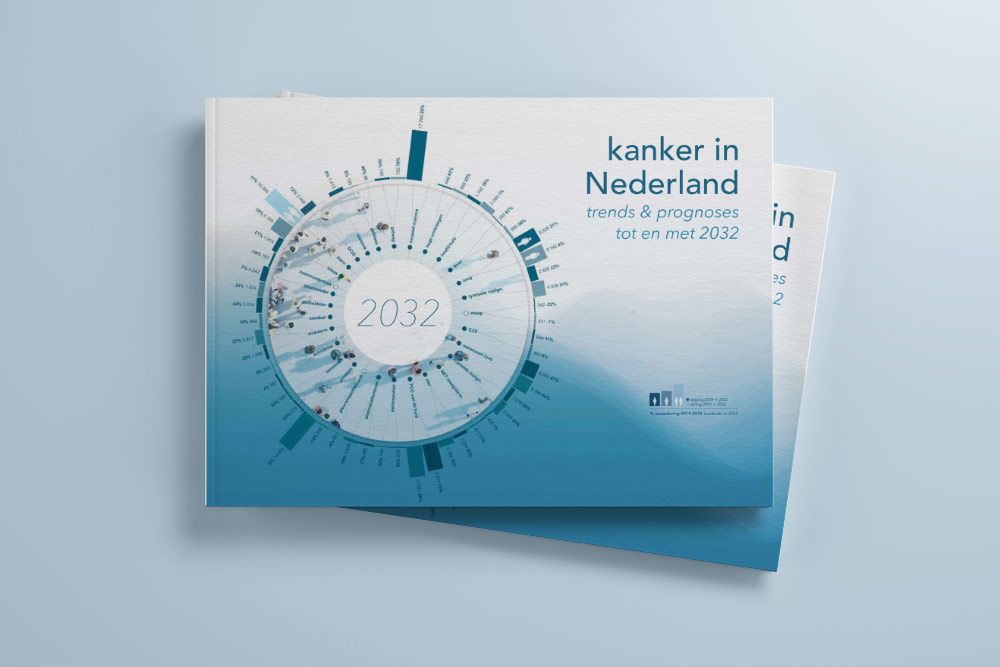
Cancer diagnoses in the Netherlands rising to 156,000 a year in the next decade
The number of new cancer diagnoses in the Netherlands is to rise considerably to 156,000 diagnoses a year in the next ten years, due to the ageing population and lifestyle. This increase in the coming ten years is largely inevitable, but commitment to preventative measures now is necessary to prevent a further increase in the number of cancer diagnoses in the more distant future. This is shown in the trend report ‘Kanker in Nederland - trends & prognoses tot en met 2032’ (Cancer in the Netherlands - trends and prognoses until 2032) that the Netherlands Comprehensive Cancer Organisation (IKNL) published on the 4th of October.
In 1989 there were almost 56,000 cancer diagnoses, in 2019 that number had increased to more than 118,000. In 2032, there will be about 156,000 new cancer diagnoses. This means that in ten years, on average 18 people per hour are diagnosed with cancer in the Netherlands. The most common form of skin cancer (basal cell carcinoma) and a precursor to breast cancer (DCIS) are not included in this number. If these two types are included, the total number comes to about 232,000 new diagnoses in 2032.
Ageing population and lifestyle
The strong increase is mostly due to the growth and double ageing of the Dutch population: we are dealing with more elderly people who are progressively becoming older. Cancer is a disease that mostly affects the elderly, thus the number of cancer diagnoses is mostly increasing among elderly people. Furthermore, the increase in cancer diagnosis is caused by lifestyle. Risk factors are, among others, smoking, alcohol use, overweight and little exercise. The number of skin cancer diagnosis is increasing the most. These diagnoses are increasing due to too much exposure to UV-radiation from the sun and sun beds. Finally, a small part of the increase of the number diagnosis can be explained by improvements in (early) diagnostics, enabling smaller tumours to be found that could not be found in the past.
Prevention
The predicted increase in cancer diagnoses in the next ten years is mostly due to ageing and exposure to risk factors in the past and therefore mostly inevitable. However, what we can do as a society is ensuring that we limit the increase in new diagnoses in the more distant future by committing to preventative measures. Preventative measures aimed at smoking can decrease the number of diagnoses of, among others, lung cancer, throat cancer, bladder cancer and kidney cancer. Focussing on a healthy weight can stop the striking increase of cancer diagnoses related to overweight like liver, bile duct, oesophagus and kidney cancer. Additionally, stimulating a decrease in alcohol use can reduce the number of breast, intestinal, liver and head and neck cancer diagnoses. The rise in the number of skin cancer diagnoses can be halted by mitigating exposure to UV-radiation from the sun and sun beds. It is important that preventative measures are target-group oriented, because there are great differences in the preventing of risk factors between population groups.
More people live or after cancer
The number of diagnoses is increasing, but at the same time the risk to die of cancer decreases. Thus, there are more and more people who live with or after cancer. The expectation is that in the next five years, the number of people will pass 1,000,000. In 2032 that number will be almost 1.4 million, which amounts to one in 13 Dutch people. People with a prostate, breast or skin cancer diagnosis make up the largest group in that number.
Healthcare jam
The Scientific Council for Government Policy calculated that if we do not set up our healthcare system differently, in 2030 one in five people has to work in healthcare. Thijs Merkx, Chair of the Board of Directors at IKNL: ‘Our healthcare system is facing a big challenge. We have to enable caregivers to apply themselves to the healthcare demands of the future. People will be older on average and will suffer from other ailments alongside cancer.’ The report suggests more effective organisation of healthcare as one of the solution approaches. Merkx: ‘Less caregivers will have to help more patients. This is possible through broader cooperation in networks. In addition, we will have to commit to appropriate care, and look at how we can deploy available capacity and financial resources as responsibly as possible for patients. Working in healthcare also has to become more attractive and more accessible.’ That is why IKNL argues for a digital ecosystem, by connecting data sources and investing more in uniform, safe and quickly available data.
Societal consequences
There are also big consequences for society. More and more people are living with or after cancer, with the symptoms and long-term effects of their cancer and the treatment of it, like fatigue, neuropathy (tingling in the hands and feet), and cognitive issues. It is important that they can return to work, do volunteering work and contribute to society in other ways. Valery Lemmens, member of the Board of Directors at IKNL: ‘We will have to pay attention to these effects. By researching quality of life and looking into the possibility of making treatments less intensive. Aftercare also remains important.’ The report also discusses the palliative phase, which is relevant to cancer and many other ailments. Lemmens: 'It is important that the wishes and needs surrounding palliative care are discussed in time, preferably during treatment.’
Preventative measures and conservation of good care demand the cooperative dedication of many different parties. Further connection and coordination is necessary to reduce the impact of cancer in the Netherland together with all involved parties.